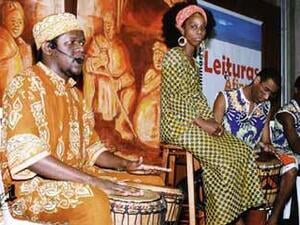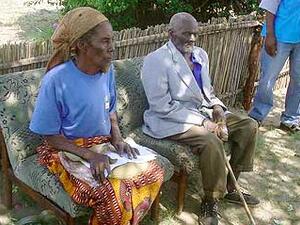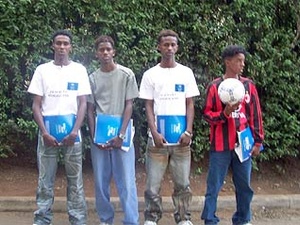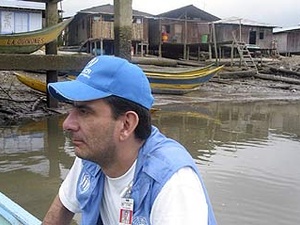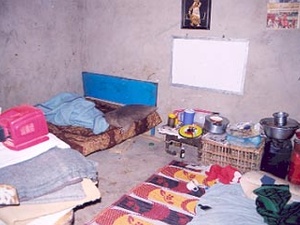New home and hope for refugees in Mozambique
New home and hope for refugees in Mozambique
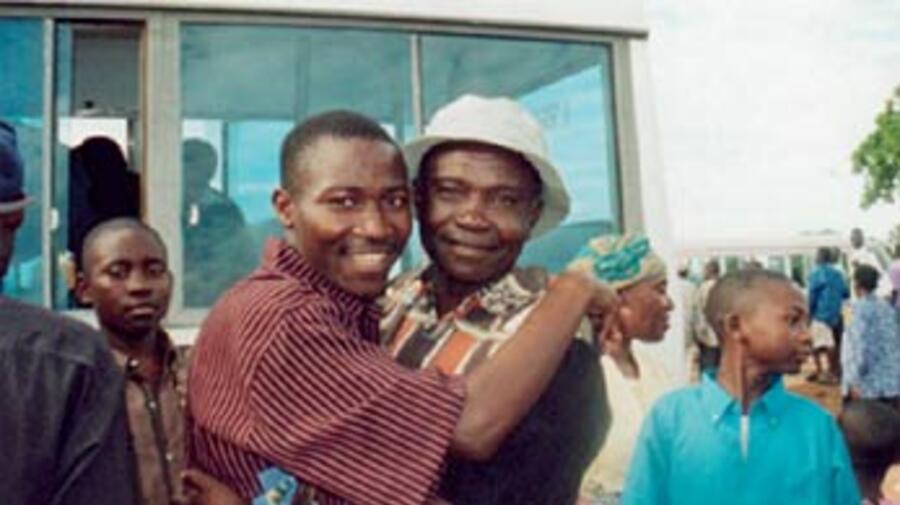
A father and son reunited after the final convoy from Bobole camp arrives in Marratane camp.
MAPUTO, Mozambique (UNHCR) - It is 5 a.m. and a tired but determined team awakens 53 residents of the soon-to-be-closed Bobole refugee camp in Maputo, Mozambique's capital.
Organised by the UN refugee agency, Nucleo de Apoio aos Refugiados (NAR, UNHCR's government partner), and the International Organization for Migration (IOM), this March 26 convoy is the fifth and final transfer of refugees and asylum seekers to their new home in Nampula province, more than 2,000 km north of Maputo.
An air of excitement and expectancy engulfs Bobole as its inhabitants in varying stages of readiness chatter, laugh and cajole each other to hurry up. Most of them cannot wait to see family and friends who took advantage of earlier transfers, which began in December last year. Some, especially the families here, know that they will receive accommodation the following day. They clearly relish the independence and pride that comes with being homeowners.
Dressed to the nines - men in spanking new jeans, their wives regal in African print and newly styled hair, children awkward in their new shoes and Sunday best - they eventually make their way to Mozambique National Airport. It is a two-hour journey spent avoiding mangy dogs and potholes that are so much a feature of the roads here.
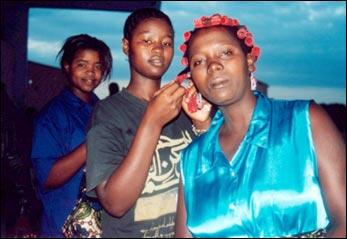
Bobole's inhabitants getting up at daybreak to look their best for the move to Marratane camp.
The mood today belies the anger and animosity that was once the general feeling towards the Mozambican government's decision to relocate these refugees to Nampula province.
Before the transfer, Bobole camp hosted some 1,100 people, mostly asylum seekers. In all, some 650 have been relocated to Nampula province; the rest have chosen to stay in the capital or to move elsewhere without UNHCR assistance.
Explaining the relocation, Nicole Engering, the project manager for IOM, says, "Bobole camp was seen as temporary accommodation after which people would move to the city. But the numbers of asylum seekers increased beyond capacity. There were not enough facilities here and the government felt that it would be more appropriate to have a camp up north, closer to the borders where people are gaining entry into Mozambique."
Engering suspects that the government was also faced with political pressure from South Africa to tighten its borders, because of the number of people - both Mozambican migrants and refugees - using Mozambique as a transit country before crossing into South Africa.
The former camp administrator for Bobole, NAR official Aderito Matangala, says, "In Nampula, there's more land available, more opportunities and less competition for scarce resources as was the case in Maputo. After scouting around for different sites, we decided on Marratane camp because of its location and opportunities."
The closure of Bobole camp also has protection implications. Since 1999, the Minister of the Interior has refused to confirm or reject asylum applications until all refugees and asylum seekers are moved from the capital to Nampula province. "From a protection point of view, with the closure of Massaka and Bobole refugee camps in Maputo, the government has committed itself to reducing the backlog of asylum applications that have not been processed in the last four years," explains UNHCR's associate protection officer, Elisabeth da Costa.
A vigorous information campaign was launched to inform Bobole's refugees of the move. The implementing agencies held meetings with all partners present - community, church and women's leaders - to explain each organisation's role in Nampula. They also arranged for question-and-answer sessions with the refugees.
"The atmosphere at these meetings was very nasty," recalls Engering. "Refugees unearthed a whole gamut of complaints, accusations and counter-accusations to resist this move. I think we gave them an opportunity to express every frustration in the last five years, from their countries of origin, Mozambique and wherever they'd been in between. We endured lengthy sessions of up to 10 hours, just to get them to agree. I won't forget that episode in a hurry, believe me!"
NAR's Matangala added that the refugees had no choice but to move because the government had decided to discontinue assistance in Bobole from April 1. They could either move to Maputo city, where they had to provide for themselves, or relocate to Nampula.
"Fortunately, the people who first arrived in Nampula - from Lichinga, for example - gave very positive feedback to the inhabitants of this camp," says Engering.
As the aircraft circles Nampula city, the incoming refugees see a semi-urban sprawl from a colonial era long gone. Its decaying and faded buildings sit cheek by jowl with encroaching mud huts and makeshift businesses, unsteady on rickety foundations. Its lush and green flora elicits a murmur of approval among the passengers. It is a fertile province, boasting a variety of indigenous fruit and vegetables. With a population of some 700,000 people, it is Mozambique's second most populous centre.
Everybody disembarks from the plane to a muggy afternoon and a hearty welcome, delivered in Portuguese and translated into Swahili. The refugees, now visibly wilting in the heat, bounce along the final stretch of cyclone-damaged road towards their new home.
Not too long ago, Marratane refugee camp was just a village. There were a few destroyed buildings with a small local population. A market of all but five stands was the village gathering place. There, a nurse provided treatment and dispensed advice under a tree. It was a very remote and undeveloped area.
Slowly the government has rehabilitated all the buildings. The health centre now attracts both refugees and a significant number of locals. A primary school was built and teachers were appointed. Refugees who initially put up in tents later moved into their own houses. All the homes of the earlier arrivals are surrounded by gardens flourishing with groundnuts, sweet potato, wild spinach and pumpkin leaves.
While the new arrivals from Bobole look enviously at what they too will accomplish one day, their consolation is that the government of Mozambique and UNHCR will make good on their promise. Tomorrow, when the refugees are presented with their houses - built to shell level - and given their food rations, they too, will be well on the way to catching up with their prospering neighbours.
Meanwhile, they prepare to get ready for the night - grass mats are handed out and supper is served from the common kitchen. As the men re-establish links with other men in the fading light, tired but smiling mothers warn their children not to ruin their clothes or get lost in this new place.
Many look glad to have made the long journey to Marratane.
In all, Mozambique has formally granted status to only 207 refugees originating predominantly from the Great Lakes region and the Democratic Republic of the Congo (DRC). They comprise a number of small families and a significant number of single males, among them, a sizeable number of irregular movers - people who have lived in camps in countries like Zambia, Tanzania, Zimbabwe before moving on to Mozambique, and perhaps eventually ending up in South Africa.
According to government estimates, Mozambique also hosts more than 7,000 asylum seekers.
By Pumla Rulashe
UNHCR South Africa


